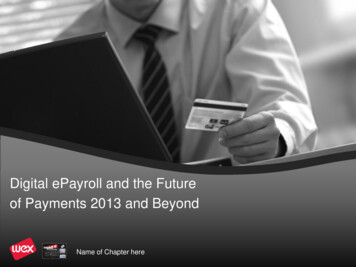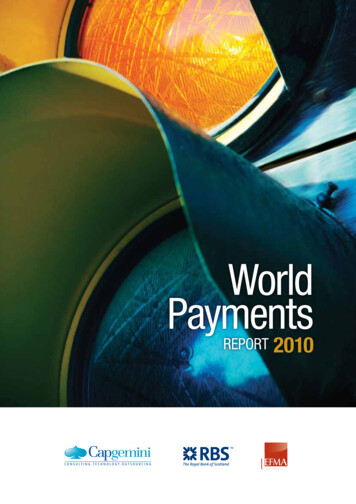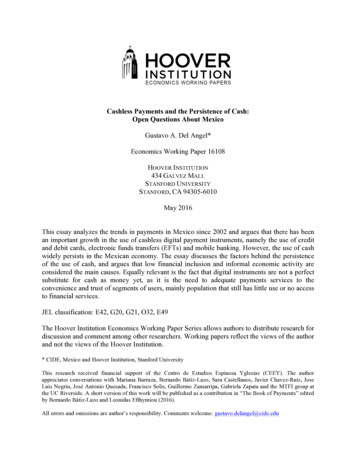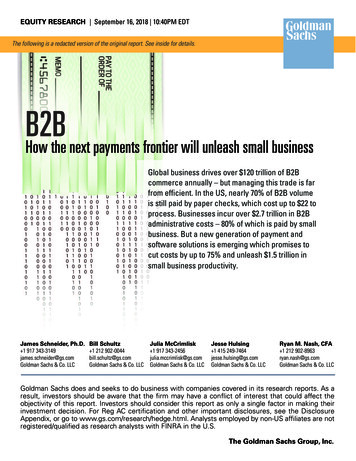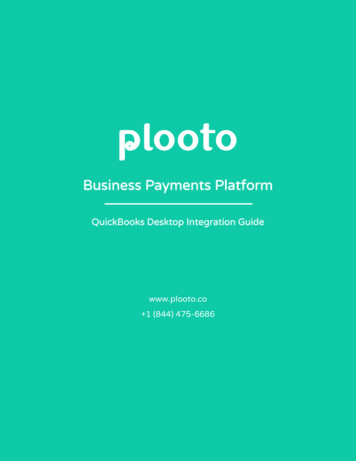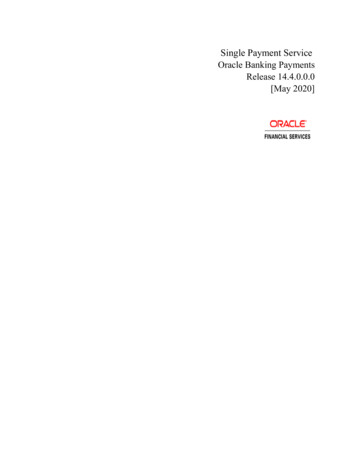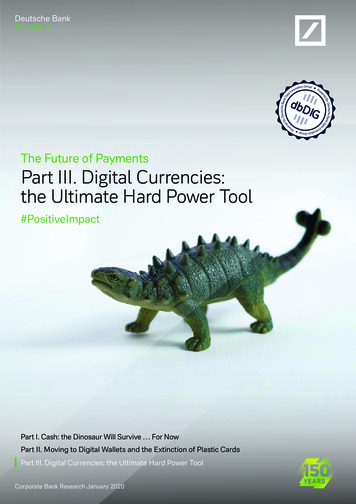
Transcription
Deutsche BankResearchDeutsche BankByDaedterdbDPowPart III. Digital Currencies:the Ultimate Hard Power Tool#PositiveImpactPart I. Cash: the Dinosaur Will Survive For NowPart II. Moving to Digital Wallets and the Extinction of Plastic CardsPart III. Digital Currencies: the Ultimate Hard Power ToolCorporate Bank Research January 2020IGtion GroupovannaIThe Future of PaymentsPowDeutsche BankByDaedtertion GroupovannaI
My personal conviction on the issue of stable coins is that webetter be ahead of the curve. There is clearly demand out therethat we have to respond to.ECB President Christine LagardeI think the Internet is going to be one of the major forces forreducing the role of government. The one thing that’s missingbut that will soon be developed, is a reliable e-cash, a methodwhereby on the Internet you can transfer funds from A to B withoutA knowing B or B knowing A. The way I can take a 20 bill hand itover to you and then there’s no record of where it came from.You may get that without knowing who I am. That kind of thing willdevelop on the Internet and that will make it even easier for peopleusing the Internet. Of course, it has its negative side. It means thegangsters, the people who are engaged in illegal transactions,will also have an easier way to carry on their business.Professor Milton Friedman in 1999, Nobel Prize winnerDeutsche Bank Research / The Future of Payments: Part III. Digital Currencies: the Ultimate Hard Power Tool2
Summary on a PageWhen people discuss the future of payments they tend to predict the end of cash. Our view isdifferent. Not only do we think cash will be around for a long time, we see the transition to digitalpayments as having the potential to do no less than rebalance global economic power.This piece is the third in a series of three pieces that examines the past, present, and future of thepayments industry. We analyse the unexpected results of our proprietary survey of 3,600 customersacross the US, UK, China, Germany, France and Italy and forecast trends in cash, online, mobile,crypto, and blockchain. The implications for customers and business are important; the potentialmacro and geopolitical consequences are profound.We start by using the lessons of history to predict that cash will be a part of the economy fordecades to come. Over centuries, people have developed a deep-rooted trust in paper and coinsduring uncertain times. Today is no different. For example, the trade war between the US and Chinahas led notable investors to increase their cash holdings. Our survey shows that people also like cashbecause it allows them to more easily track their spending.While cash will stay, the coming decade will see digital payments grow at light speed. That will leadto the death of the plastic card. Over the next five years, we expect mobile payments to comprisetwo-fifths of in-store purchases in the US, quadruple the current level. Similar growth is expected inother developed countries, however, different countries will see different levels of shrinkage in cashand plastic cards. In emerging markets, the effect could arrive even sooner. Many customers in thesecountries are transitioning directly from cash to mobile payments without ever owning a plastic card.Digitalisation will give businesses extra incentive to smooth the payments transition. For starters,when customers are comfortable with a payment technology, they tend to think less about howmuch they spend. Furthermore, as the data gleaned from payments becomes increasingly valuable,payment fees will approach zero. Business-to-business transactions will also benefit. Currently,corporates wait almost 70 days for payment from business customers. The number one reason forthis is inefficient internal processes which lead to payment delays, something digitalisation can fix.We can deduce much about the future of payments from developments in China where the countryis developing world-leading digital payments infrastructure. There, the value of online payments isequivalent to three-quarters of GDP, almost double the proportion in 2012. Today, just under half ofin-store purchases in China are made via a digital wallet, way above the levels in developed markets.As China (and India) develop electronic, crypto, and peer-to-peer strategies, the epicentre of globaleconomic power could shift. China is working on a digital currency backed by its central bank thatcould be used as a soft- or hard-power tool. In fact, if companies doing business in China are forcedto adopt a digital yuan, it will certainly erode the dollar’s primacy in the global financial market.Many are sceptical about digital currencies citing the large energy needs and point out thatcurrencies such as bitcoin and Facebook’s libra have encountered significant regulatory hurdles.Yet, if the growth in blockchain wallet users continues to mirror that of internet users, then by theend of the decade, they will number 200 million, quadruple the current level. This will be encouragedby governments, banks, corporates, and payment providers who all stand to benefit from thedigitalisation of payments. And when countries and companies eventually look back at the way theytransitioned to digital payments, it may become very apparent how they achieved their standing inthe world economy.AuthorsMarion Laboure, Ph.D. marion.laboure@db.comJim Reid jim.reid@db.comDeutsche Bank Research / The Future of Payments: Part III. Digital Currencies: the Ultimate Hard Power Tool3
Introduction: From Globalisationto DecouplingStill in their infancy, digital currencies have the potential to radically change payments, banking, centralbanking, and the balance of economic power. We have already moved away from the gold standard tofiat money, so why could we not take the next leap toward a digital currency?Digital currencies (sometimes also referred as digital money, electronic money or electronic currency),either privately- or publicly-issued, are a type of currency available in digital form. Examples includevirtual currencies, cryptocurrencies and central bank digital currency (CBDC). Digital money can eitherbe centralized, where there is a central point of control over the money supply, or decentralized, wherethe control over the money supply can come from various sources.The money flower: a taxonomy of moneyDigitalCentral bank-issuedVirtual currencyWidely accessiblePeer-to-peer(Token-based)Central bankreserves &settlementaccountsBankdepositsCentral Bankdigital tokens(wholesale only)Central bankdigital currencyCentral Bankdigital tokens(retail)CashLocalcurrencyPrivate digital tokens(wholesale ymoneyPrivate digital tokens (generalpurpose) include crypto-assetsand currencies, such as bitcoinSource: Adaptation from Bank for International Settlements (2017) based on Bech and Garratt (2017). Notes: The Venn-diagram illustrates the four key properties ofmoney: issuer (central bank or not); form (digital or physical); accessibility (widely or restricted); and technology (account-based or token-based). Bank deposits are notwidely accessible in all jurisdictions.We believe a new digital currency could become mainstream within the next two years. In the long run,a digital currency could eventually replace cash (see our essay titled Cryptocurrencies: The Twenty-FirstCentury Cash).The main contestants for a mainstream digital currency, at this time, are Facebook’s libra and the Chinesegovernment’s digital currency. Facebook, with nearly 2.5 billion users (one-third of the world’s population),and China, with more than 1.4 billion inhabitants, have the potential to advance digital currencies into themainstream.1 The Bank of International Settlements defined three examples of current technological and design features of crypto-assets relative to other traditionalassets: (1) they are digital and virtual in nature; (2) they rely on cryptography and advanced mathematical techniques to restrict the transmission of data to theintended parties; (2) they use distributed ledger technology.Deutsche Bank Research / The Future of Payments: Part III. Digital Currencies: the Ultimate Hard Power Tool4
Facebook announced its proposed cryptocurrency and payment system, libra, in June 2019. The launchhad been planned for early 2020 but it now seems that the end of 2020 or later is more likely.At the end of 2019, the Chinese government, without a formal announcement, stated it would belaunching a People’s Bank of China (PBoC) digital currency. The plans were finalised and approved inOctober 2019, so a pilot launch at the end of 2020 seems plausible. If this materialises as expected,China will become the first major economy to use a digital currency. That will pressure other countriesto set up their own digital currencies. A government-issued digital currency could be a powerful politicaland economic tool for China.To break into the global payment market, digital currencies must overcome some headwinds and forgealliances with key stakeholders. These might include mobile payment apps (Alipay, WeChat Pay, ApplePay, Google Pay), card providers, and worldwide retailers (Alibaba, Amazon, Walmart). Assuming that (a)governments back them; and (b) they become stable; and (c) consumers and merchants can get morevalue by using these new currencies, then increased adoption rates will more rapidly lead to mainstreamuse. We are still in the early days of change, but if current trends continue, there could be two hundredmillion blockchain wallet users by 2030.Our exclusive survey of 3,600 customers in China, France, Germany, Italy, the UK, and the US found thatmillennials envision a purely digital currency. A large majority of millennials believe cryptocurrencies willbe good for the economy and said they have already bought and sold a cryptocurrency. More than a thirdof millennials believe that cryptocurrencies are already replacing cash.The final section of this report focuses on factors that promote and hinder the adoption ofcryptocurrencies. We present an overview of how private and government sectors are embracing (or not)this new technological reality. Finally, we consider what the global economy will look like if (or when) adigital currency emerges in China.Deutsche Bank Research / The Future of Payments: Part III. Digital Currencies: the Ultimate Hard Power Tool5
Current Adoption Rates of Cryptocurrencies:Age and Cultural FactorsFor investors, crypto-assets have numerous advantages compared to traditional assets, which couldlead more and more people to use cryptocurrencies. First, they could offer a low or negative correlationwith financial assets, meaning they might not be driven by interest rates. Second, they can decomposecomposite returns, thereby offering a more precise exposure to alpha return components; that is,they can enable people to trade a revenue stream that comprises a share price/ROE, somewhat likesecuritisation. Third, a cryptocurrency can enable individual assets to be compiled into a compositeasset for better return profiles, like a “composable token” or SET protocol. Fourth, cryptocurrencies canfractionalise financial assets for accessible investments.Cryptocurrencies have been around for about a decade, but it was not until 2017, when bitcoin’sprice surged to nearly 20,000, that they grabbed significant global attention. If we connect the dotsbetween the dematerialisation of payments and the rise of cryptocurrencies, we can envision a nearfuture in which cryptocurrencies gain broad acceptance. This view is supported by trends among younggenerations who readily accept digital currencies and payments.Overall, though, relatively few people have bought and sold cryptocurrencies. They are largely seen as asupplementary means of financial transactions rather than as necessary or advantageous substitutes formainstream methods. They have not been widely accepted as a means of payments despite their wellknown benefits: security, speed, minimal transaction fees, ease of storage, and relevance in the digital era.Today’s adoption rates could, and likely will, change. If the Chinese government, along with Google,Amazon, Facebook, or Apple (the so-called GAFA group), or a Chinese company like Tencent canovercome some of the barriers to cryptocurrencies (discussed later), then cryptocurrencies could becomemore appealing. This will hasten their adoption and give them the potential to replace cash.The chart below shows the adoption rate of blockchain wallets as compared to the adoption rate of theInternet. At least for now, the curves are similar after adjusting for scale. If current trends continue, therecould be two hundred million blockchain wallet users by 2030.Number of Internet users (in millions)4,000400Number of Internet users (lhs)Number of Blockchain wallet users (rhs)DB forecast of number of Blockchain wallet users ,00050010050202001234567890Number of Blockchain wallet users (in millions)Adoption rates of cryptocurrencies and the Internet10 11 12 13 14 15 16 17 18 19 20 21 22 23 24Number of Internet users (in millions)Sources: Deutsche Bank calculations, InternetWorldStats.com, and Blockchain.com. We measured “adoption rate” by the number of users adopting the Internetand bitcoin since each went public. In this case, the Internet and bitcoin have been public for different lengths of time. The Internet has been around since the1980s but went public in 1991. Bitcoin was launched in 2009 but it became publicly accepted in 2011. Year one for the Internet is 1991 and for bitcoin it is 2011.To forecast the number of blockchain wallet users, we applied the growth rate of the number of Internet users.Deutsche Bank Research / The Future of Payments: Part III. Digital Currencies: the Ultimate Hard Power Tool6
With those broad perspectives in mind, we can then look more closely at the adoption rates as affected by ageand culture.C
is developing world-leading digital payments infrastructure. There, the value of online payments is equivalent to three-quarters of GDP, almost double the proportion in 2012. Today, just under half of in-store purchases in China are made via a digital wallet, way above the levels in developed markets. As China (and India) develop electronic, crypto, and peer-to-peer strategies, the epicentre .
